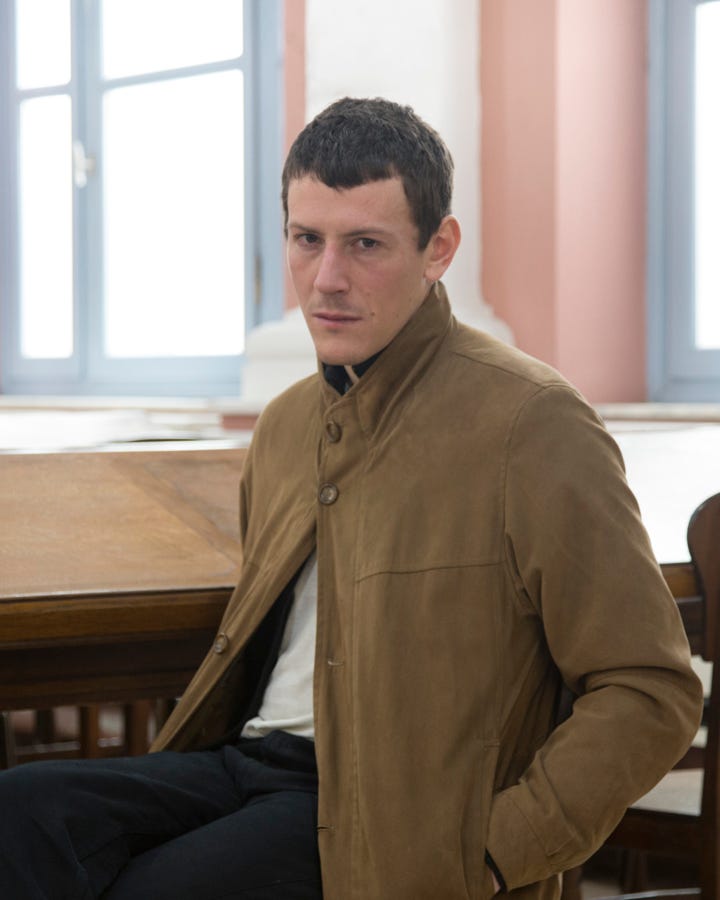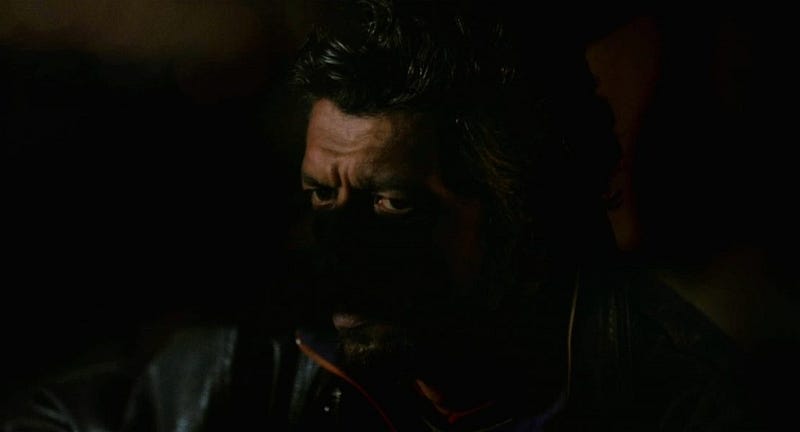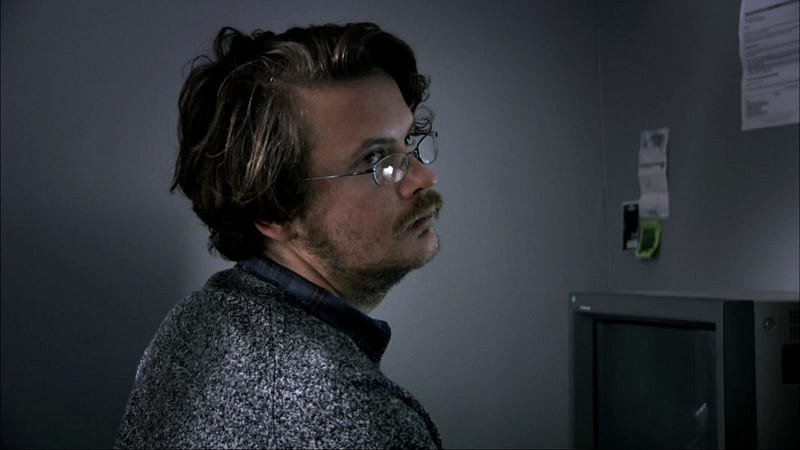11.02.2020
Searching for Meaning and Making Change in the Films of Loukianos Moshonas
Κινουμενη εικονα
Γλώσσα πρωτότυπου κειμένου: Αγγλικά
One drop fell from a fern, and lo, a ripple
Shook whatever it was lay there at bottom,
Blurred it, blotted it out. What was that whiteness?
Truth? A pebble of quartz? For once, then, something.
— Robert Frost, For Once, Then, Something
Pure abstraction has a long history in cinema. Some of the earliest moving images — made with the stroboscope or phénakisticope — were nothing more than simple lines and shapes brought into flickering life. Yet amidst even the most basic stirrings of movement, we look for meaning. It is impossible to watch a film, to follow something closely with our eyes and our minds, and not attach some significance or feeling to its rhythms. Indeed, this elemental search lies at the core of the work of filmmaker and artist Loukianos Moshonas. Grounding his narratives in the specific, yet universal, mundanities of everyday life, Loukianos reveals our tireless attempts to make sense of the world, all while recognizing that absolute certainty will forever remain just beyond our grasp.
Loukianos was born in Athens to a French mother and Greek father. Educated in the city’s French school, his greatest passion growing up was not film, but skateboarding. Driven by his love for the sport, he chose to pursue studies at the National Art School of Lyon, his decision stemming not from any particularly strong affinities to the university (or even to art, he thought), but rather to Lyon itself, one of the skating capitals of Europe. Soon enough, though, art school took him by surprise. As he began to immerse himself in both the history and practice of art, he found himself challenged by his studies in a way he had never before experienced. Creating art, especially video art, quickly became his guiding obsession.

From there, the vast world of film beckoned. Drawing on the bottomless devotion of the freshly converted, he absorbed everything he could about this visual and narrative craft. He dedicated himself to darkened cinemas, faithfully taking in two films per day. His intense absorption into the medium was no accident — it spoke to the immediacy of cinema, its direct ability to capture life itself. Loukianos says, “When shooting, you depend so much on the real — its hazards, accidents, chance. With a fine scalpel, you cut into these infinitesimal nuances. Sitting in front of a screen, you see a culture and its filters as thin as possible; you’re a hostage of this presence. You laugh, you cry, you’re melancholic: no choice. Both are terrifying.” When art school concluded, Loukianos moved to Paris, the longtime capital of his new passion. There, he continued his studies at Le Fresnoy, a film school where clear-cut narratives and high-end productions are deliberately disdained in favor of formal experimentation and the search for ways of challenging cinematic conventions.
As Loukianos narrativizes and compresses his formative years, a pattern clearly emerges — what is obsession if not a search for meaning? We pour ourselves into something, expecting that somehow our efforts will eventually be rewarded. Perhaps not financially, but at least intellectually or socially or emotionally, or, most fundamentally, by granting us a sense of purpose. When Loukianos began his artistic career, he had more than enough obsession to drive him, but he had to find a way to convey that same meaning to his viewers through his work. Indeed, the first two projects that Loukianos produced during and after his time at Le Fresnoy followed a similar arc. They took shape slowly, at their own pace, striving to find a satisfying form — a process reflected in their own narratives.
The first film tells the initially mundane story of two programmers working side by side in a drab office. At the beginning, they stare at their screens and click aimlessly, the creative process made dull and empty by the numbing atmosphere. As viewers, we stare at the screen and watch the two men stare at their own screens in return. We recognize in them the daily alienation of our own speech, and our own bodies, illuminated by the numbing glow of technology. But slowly, as the two men begin to engage in deeper conversation, something clicks into life. Loukianos describes how, “This pair of young men brainstorm together, allowing their minds to travel.” Soon, we join them on their journey and discover an ambiguous digital image on one of the character’s computer screens. Somewhere in the swirl of pixels, there lies a referent to something, but the men can’t seem to agree what it could be. Meanwhile, in the real world, Loukianos himself confronted the same problem as his characters. He cut and cut his film, but like the ambiguous squiggle that his characters debated, it refused to resolve with conclusive clarity. He completed this short, but the shadow of a larger feature seemed to beckon from within.
The first film tells the initially mundane story of two programmers working side by side in a drab office. At the beginning, they stare at their screens and click aimlessly, the creative process made dull and empty by the numbing atmosphere. As viewers, we stare at the screen and watch the two men stare at their own screens in return. We recognize in them the daily alienation of our own speech, and our own bodies, illuminated by the numbing glow of technology. But slowly, as the two men begin to engage in deeper conversation, something clicks into life. Loukianos describes how, “This pair of young men brainstorm together, allowing their minds to travel.” Soon, we join them on their journey and discover an ambiguous digital image on one of the character’s computer screens. Somewhere in the swirl of pixels, there lies a referent to something, but the men can’t seem to agree what it could be. Meanwhile, in the real world, Loukianos himself confronted the same problem as his characters. He cut and cut his film, but like the ambiguous squiggle that his characters debated, it refused to resolve with conclusive clarity. He completed this short, but the shadow of a larger feature seemed to beckon from within.
Meanwhile, in 2013, Loukianos was called back to Athens after having spent nearly a decade in France. Growing up in Greece, Loukianos had often felt that his bilingual upbringing was some kind of deficiency, a feeling of foreignness that followed him everywhere he went. While this was a problem, it was also a spur: he questioned everything, from language, to work, to our most basic social, historical, and political assumptions. When he began making films, this eternally outside perspective became an asset; he found himself drawn to tell stories and create characters who were also searching for their place in the world.
Once more, then, Loukianos’ life reflected in his art. In Athens, he began renovating an old family apartment with the help of a more technically skilled contractor, born in Albania. As the two worked and got to know each other, Loukianos saw the outlines of a new project. Soon, they were collaborating not only on the renovation, but on a film, titled Manodopera, in which Loukianos portrays a young Greek man working together with an older Albanian to refurbish an apartment. The scenes of demolition and reconstruction are intercut with ones on the roof of the same building, where Loukianos’ character sits with a group of friends overlooking the city. Amidst the descending darkness, the men discuss Greece, politics, and their existential worries about the future. Above and below, we find characters seeking to create structures; all of them outsiders, in different ways, alienated from their surroundings. Through their labor, they attempt to carve out a sense of ownership or belonging, but even work is an uncertain refuge.

Still the practical project advances, and we watch as the apartment is steadily transformed. Yet in the circuitous conversations on the roof, the theoretical efforts languish. As Loukianos tells me, “The youths slowly succumb to a melancholic state where they realize they have no answers. Their conversation is not a quest for truth but simply a confrontation with the real — that is, their ongoing state of confusion. Over the course of the film, they talk into the night and the darkness becomes totally black. At the end, they are floating in the sky, in a void, an untethered state.” He then explains, “To me, this film suggests a navigation amidst boundless information and opportunity, while facing an emptiness and existential uncertainty. It seems like the earth underneath our feet is slipping, causing us to lose our balance. We drink too much and stumble across bits and pieces of answers, but only end up in a jumbled frame of mind.”
It is here that I ask Loukianos about the process of editing, imposing structure on films that themselves admit to the challenge of finding meaning. What did he do when he found himself at temporary impasses while working on these two projects? It takes Loukianos a moment to gather his thoughts. “When you have a lot of footage, it’s like trying to find a diamond amidst the muck. But with persistence, you condense the meaning and bring out the beauty for which you are searching.” He then continues in more concrete detail, “It also depends on the film. In the case of Manodopera, I kept pushing the material further because I imagined something better. In fact, it was only after I fleshed out my idea for a feature-length structure that I could go back and produce the short version. Once I did that, I felt a breakthrough.” After a pause, unprompted, he offers another thought, “I’ve slowly accepted that this journey is all part of the creative process. It’s as if the films themselves are searching for their own form. Their structure is not sleek and direct. Instead, I allow my films breath. I have a strange love for editing — a love that lets the process shine through. My editing is not asphyxiating nor perfect, but open and ongoing.”
As he speaks, I realize that Loukianos, unlike so many filmmakers and visual artists, is less interested in showing us the final results of his imagination, but rather, revealing the very process of imagining. It is engrossing but also a struggle: with all its breaths, and messiness, and pauses, and roundabout detours.
When I suggest this to him, he agrees and elaborates, “I like the belief that once you are able to think about something, it’s already palpable; you can almost touch it. The filmmaker Stanley Kubrick said once you have the idea, that already means it’s possible. The fact it could form into an idea at all shows there is a way to make it happen.” From Kubrick, he turns his reflections inward, “My own films work a lot with storytelling through speech, the power of fabulation. Spoken words can be convincing, seductive, capable of transporting us to other places. They are so enchanting [envoûtant] that they pull you inside before you know it. I am interested in the range of possibilities produced by speech, rather than any single realization through the image. I often prefer storytellers to the story itself; imagining can be more evocative than seeing.”
As Loukianos speaks, it is easy to nod along. Yet his words seem odd for a filmmaker, an art form so linked with the image. Why does he choose to work with a camera if speech is so powerful? He is ready with an answer. “I really mistrust the image. Instead, I double my faith in the expressive tool of speech and sound. It’s like the filmmaker Robert Bresson once said (roughly), ‘The ear goes to fetch things that the eye does not. If you see a picture of a train station, you don’t do any work. If you hear the sound of the train station, you imagine not one or two trains, but maybe a dozen of them. You picture in your mind the rush of hundreds of people and suddenly you are immersed in an entire world. The eye is lazy while sound runs much more deeply.’ I fully agree — sound is both rich and elusive. Images make so much available right on the surface; sounds invite you in for more.” He continues, passionately, “Everyone says eyes are the windows to the soul. But for me, the window to the soul is one’s voice. You can’t fake it: it’s too fragile, it trembles and derails your intentions. Likewise, any image you see on a screen is necessarily fake; you look and know that it has only two dimensions. But sound fills the air, it envelops you. When someone whispers in a cinema, you can feel their lips moving in your ear. That’s why I love sounds and voices. The voice of the character brings you into their world.”

He then winds down his defense of the auditory in film with the following reflection: “Think about the old adage, ‘Show, don’t tell.’ That’s the rule and you’ll find it on every bullshit list on how to tell stories. But it’s not true, or at least, it’s very dogmatic. The idea is that we find everything through the body and our sensory experiences. But think about it: we are constantly searching through words. We talk in order to make meaning. The mystery becomes the telling, our challenge is to find some truth within the profusion.”
Being a writer — and in this case, an interviewer — Loukianos’ own words resonate with me deeply. But before we conclude, I push Loukianos to apply this perspective to his film Manodopera. The entire film represents a search for truth, but via two separate means: speech, yes, but also action. While the men on the roof circle around their goal, the narrative is driven most by the muscular activity of destroying and rebuilding. Loukianos explains, “At the center of the story is the relationship between a Greek and an Albanian; their collaboration creates a dyadic attraction. I’m interested in the idea of two figures, from very different backgrounds, coming together through the building process. For a moment, their relationship evolves within a utopia, much as the philosophical discussions above seem to exist in a parallel reality. But in both cases, in order for anything to really change, they must reach down to the roots of the problem. In the case of the apartment, they destroy what’s on the surface to find the stronger foundations below. And in the larger society, all the characters must confront how in order to truly fix anything requires a painful process; durable change demands a dialectic of creation, destruction, and finally, reconstruction.”
Alexander Strecker is pursuing a PhD in Art, Art History and Visual Studies at Duke University. His research explores how artistic practices register the contradictions inherent in ideas of crisis, periphery, and technology, with a focus on how these tensions are felt acutely in contemporary Greece while also resonating worldwide.



